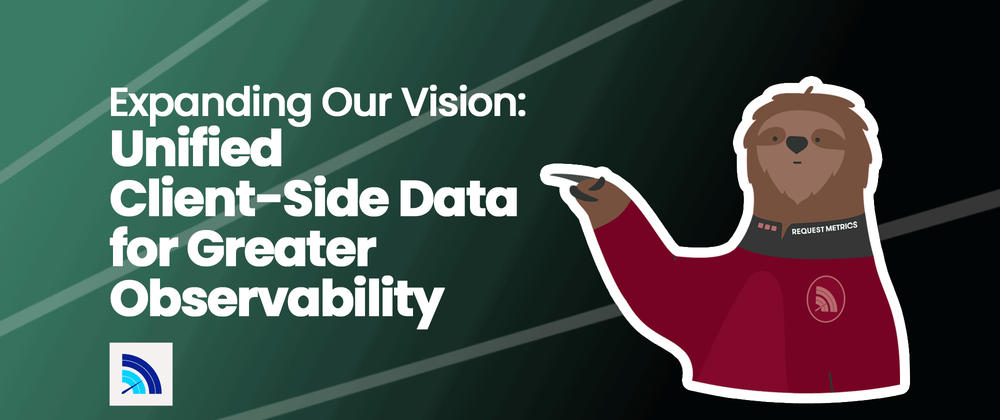In 2021, we started Request Metrics as a simple and developer-friendly service to measure and improve web performance. We built an incredible platform that distilled complex data down into simple reports and recommendations. Lots of teams around the world found valuable insights in Request Metrics that they couldn’t get anywhere else.
But web performance data can be very unpredictable—the web slows down in all sorts of ways. When one of our customer’s pages slowed down, or their Core Web Vitals slipped, we ran into 2 big limitations:
First, does this delay matter to my user? Did it cost me a sale? Do I need to fix it right now? We couldn’t answer these questions because we didn’t have enough context about what the user was trying to do.
Second, what is causing this thing to be slow? We can’t always recreate the problem in our local environments, and we didn’t have deep enough data to debug individual sessions.
To address these problems, we needed to think bigger!
A Challenge Beyond Web Performance
The limitations we faced aren’t limited to web performance. When there’s a JavaScript error, how do we know if it has user impact? When an API is failing, does it halt the checkout flow? When a user is interacting, which components do they depend on?
Today, this data is scattered across various kinds of tools, such as product analytics, error reporting, API observability, performance, and security monitoring. There is so much power to be unlocked by bringing this data together, and that’s exactly what Request Metrics is going to do.
The Client-Side Observability Platform
Our goal for Request Metrics is to bring these disparate pools of data together—to unify client-side data and reveal the correlations between user intent, product analytics, and system monitoring.
Imagine getting an alert with this context:
3 API endpoints are returning higher 500 responses than normal, and form submissions for impacted sessions are down by 75%.
We are going to combine operational problems with user impact so that we can focus on the problems that really impact our users, and cut out the noisy background radiation of the web.
Accelerating and Expanding Observability
Many monitoring products need to understand your entire infrastructure—every service, database, and backend resource you depend on. To get that, you have to deploy agents, make code changes, or use specific platforms. It’s a huge upfront cost and many small teams can’t justify it. We’re approaching the problem differently.
What if we approached observability from what the real users see, instead of our infrastructure? And what if we made the setup so easy that any engineer could do it in 1 minute. What if you could copy-paste a single bit of JavaScript into your page and get visibility into everything the user touches? That’s what we’re building: turnkey analytics and observability from the client-side.
Security and Privacy in Analytics
Many security-focused organizations are unable to use cloud services for potentially sensitive data, and have been left behind by modern analytics and monitoring vendors.
That’s why we’re making Request Metrics ready to be installed on-premise, or in your private cloud. A single install, package, and vendor to manage that can give you monitoring visibility across your teams.
Oh, and because we don’t drop a cookie or track anything identifiable about the end user (dropping IP and user agent on ingest), we’re fully GDPR compliant and ready to use anywhere you need visibility.
The Road Ahead
We have an ambitious vision, and we’re diligently working to make it a reality over the remainder of this year. Today we’ve already shipped Session Analytics, with the ability to dive into a full session timeline for users. We’re expanding our performance tools into full User Experience monitoring, allowing you to dig all the way into individual load timings and waterfalls. As well as API observability, tracking the traffic, responses, and performance of your first party and third-party API calls.
Soon, you’ll see security and website integrity reports added, so we can tell you when naughty JavaScript sneaks into your code or tries to steal data from your users. We’ll also be bringing a JavaScript error reporting component, and expanding analytics to include custom events and user journeys. There is so much great stuff coming!
Conclusion
Request Metrics is a new kind of dev tool: focused on the user experience of your site, doing more of the thinking for you, and exposing when weird things happen in your system. You shouldn’t have to feed your dev tools queries, it should just give you answers. We’re excited to make it happen and help you make better, faster software. Sign up for a free trial of Client-Side Observability.



Top comments (1)
This is about making it easier to see what’s happening on websites and apps. By combining all the data in one place, we can understand problems faster. It helps teams fix issues and make apps better for everyone.